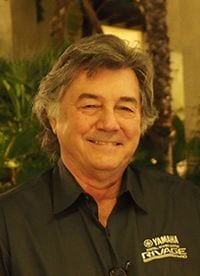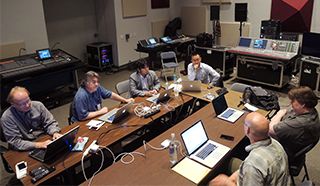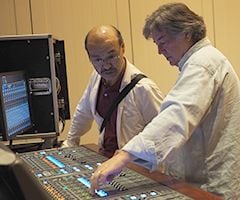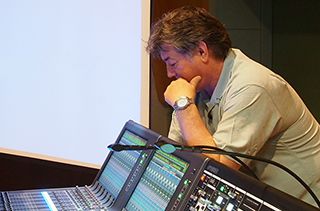Interview: Chris Taylor on the RIVAGE PM10
About Chris

Musician, mixing engineer, and sound system designer, Chris Taylor brings a lifetime of experience to Yamaha console design and development.
Chris began his career as a musician, playing in local bands, churches, and recording in his hometown of Memphis, Tennessee. He soon landed a spot as guitar player with “Up With People,” which was the beginning of a lifetime of touring and travel.
Chris’s audio career began by earning an Associate Degree in Electronic Engineering and the establishment of his own sound production company. He provided sound equipment for a long list of Country, Contemporary Christian, and R&B tours that included Conway Twitty, Kenny Rogers, Amy Grant, and The Bar Kays.
Wanting to concentrate more on the artistic side of the touring industry Chris dissolved his sound company. He began providing mixing and production skills to Contemporary Christian artist such as Amy Grant, Michael W. Smith, and DeGarmo and Key Band. During the next number of years Chris mixed other tours for such artist as Barbara Streisand, David Foster, Janet Jackson, Jewel, Kitaro, Lynyrd Skynyrd, and Michael Jackson.
Other achievements include mixing for TV Award Shows, as well as handling audio coordination and design. The 1995 Grammy Awards, CMT Video Awards, Dove Awards, and MTV awards are a few of these projects. Broadcast concert shows Chris worked on were Garth Brooks Live in Central Park, Barbara Streisand HBO Special, David Foster Hit Man, and Josh Groban PBS Special. For his contributions to these broadcast audio events Chris received an Emmy Award nomination for Outstanding Sound Mixing, and an Emmy contribution award for Outstanding Achievement in Sound Mixing. The extensive portfolio also features a number of audio and video recordings, including a Grammy Award winning album by Ashley Cleveland.
In 2003 Chris joined Yamaha first working as a District Sales Manager for Yamaha Commercial Audio Systems in the US. After 3 years of sales experience he became R&D manager for Yamaha Japan and is currently engaged in helping Yamaha build professional audio consoles.
The Interview
Tell us about your involvement in RIVAGE PM10 development, both as a member of the R&D team and as an active mixing engineer.

The process began with the R&D team getting together to decide how Yamaha’s new flagship console should look and operate. We had been working closely with console users for years and had a good understanding of their needs, so we began discussing the features that we knew Yamaha users liked and used. For example, the complete Selected Channel sections on the PM1D and PM5D were widely appreciated, although other manufacturers were moving away from that concept. We decided that a comprehensive Selected Channel functionality would be essential. When these intense discussions were done the basics of the PM10 surface and controls had been established.
The next step was to develop a suitable plug-in plan. We made a list of possibilities, and decided that Rupert Neve products would be the most appropriate and the most appreciated products for this Yamaha flagship console. The R&D team then set the stage for a strategic alliance between Yamaha and Rupert Neve Designs that would lead to some of the outstanding audio technology included in the PM10 console. Other partners contributing to the plug-in devices for the PM10 include TC Electronic and Eventide.
I became involved with Dr. K’s team, working with the VCM technology that has become a vital part of the Yamaha PM10 console.* My involvement with the VCM plug-ins was mostly from a sonic quality perspective. I worked with the team to development the transformer emulation in the hybrid microphone preamplifier and also the improved channel strip equalizers.
As we got closer to completing the operating system and hardware, some distinguished mixing engineers were brought in to evaluate the mixing system and offer their ideas. Those experts also helped to verify the quality of the new Transformer/SILK hybrid preamplifiers. Evaluations of this type continued through the project that included listening tests carried out at Yamaha headquarters in Japan.
During the prototype stage, to test the reliability and usefulness of PM10, members of the US R&D team took the consoles out and did live concerts to evaluate the operation and sound quality of the console.
* Dr. K (Mr. Toshifumi Kunimoto) heads the K’s Lab team at the Yamaha Research & Development Division where VCM (Virtual Circuitry Modeling) technology was developed.
Sonic quality is a defining feature of the RIVAGE PM10, and the Hybrid Microphone Preamplifier is a large contributing factor. What can you tell us about it?

The Yamaha designed Hybrid Microphone Preamplifier combines low distortion, low noise, high input impedance, excellent common mode rejection, and accurate reproduction of the input source. The ability to add a transformer emulation including Silk adds more depth and color approaching an analog sound from the days when digital consoles did not exists.
This new Hybrid Microphone Preamp gives engineers the best of both worlds. The mixing engineer can have the best clean digital sound available as well the ability to add the color of a great analog console, and the choice can be made on a channel-by-channel basis. The RIVAGE PM10 is the best-sounding console that Yamaha has ever made, and arguably the best-sounding live console on the market today.
The RIVAGE PM10 includes a number of plug-ins that were created in cooperation with Rupert Neve Designs. How did that collaboration come about?
Until the collaboration between Yamaha and Rupert Neve Designs, Mr. Neve has never endorsed a digital product. The only plug-ins personally approved by Rupert Neve are the products built by Yamaha.
Every Rupert Neve Designs products made by Yamaha for the digital domain must be fully approved by Rupert Neve Designs. The approval process includes direct listening comparisons between the digital product and the original analog product that it emulates.
The RIVAGE PM10 is notable not only for its sonic quality, but for its user interface as well. What makes it such a worthy successor to the PM1D?
The PM1D was widely praised for its analog-like operation with easy control access. It was a challenge to give PM10 users a similar operating feel while also offering a more modern control in a less tactile screen based system. I believe we succeeded in that goal, giving users an easy operating environment that can be used with a short learning curve. The PM10 has plenty of tactile control while allowing a screen based operation when desired.
The new User Interface design makes it easy for engineers to carry out multiple tasks when necessary, addressing one of the major complaints that seasoned engineers have had about digital consoles. The PM10 completely changes the face of digital consoles that limits engineers to just one operation at a time.
Tell us about some of the detailed refinements, like the Selected Channel layout and parameter configuration.
The selected channel was designed to be comprehensive with every control needed for channel strip operations.
For me the most important layout feature was that each bay operated in the exactly the same way. Anything you can do on the left bay you can also do on the center or right bay. This gives the operator maximum flexibility to set up the console for his or her needs. If DCAs need to be on the left, that can be done. If mix sends need to be in the center bay that can be done also. The RIVAGE PM10 is the most flexible console you can find.
The unique Sel Link and Bay Link features are very interesting too. Tell us more about the console’s flexibility features.
The console is designed to allow each user to operate in the style that he or she is use to. The main input layers are always available, for example, you can set up the console and mix without having to do extensive programming or forced to plan your channel bank layout. The availability of a fixed layout means that you won’t lose control of a channel if you make a mistake in programming. The channel you need is always available on the base layer. 12 Custom Fader layers are available on each of the 3 banks. The console is most flexible when no Sel or Bay links are selected and each fader bank can operate independently. This allows you to operate each bay separately. In this mode all Sel operation goes to the Selected Channel bay and each screen can have a different selected operation individually.
As you select Sel Link the screens are assigned to Selected Channel operation. Alternatively, you can choose to have a screen selected by the SEL button on the corresponding bay while the other bays are ignored. The Bay Link function links the bays to the bank select buttons on the other two bays.
You can operate the RIVAGE PM10 in any way that suits your preferred working style. Again, the PM10 is simply the most flexible console out there.
How were evaluations for sonic quality and the user interface carried out?

The sonic evaluation was a comparison between three consoles. We used a relay switching system that simultaneously switched both the inputs and outputs of each console. Representatives from the EU, US, Japan and internal staff were brought in to perform the blind comparison listening test. The listeners were allowed to choose the music source and switch between consoles as they pleased. All listening tests were carried out without using the PM10 digital transformer or SILK features. That was the fairest and most accurate comparison we could provide.
The user interface was mostly developed by the internal team with input provided from well-known mixing engineers. Because Yamaha consoles have been used in a major way at the monitor position we spent an extra time not only on FOH operation but also on monitor mix operations.
What was the reasoning behind the hybrid TWINLANe and Dante networking system adopted in the RIVAGE PM10?
The Yamaha TWINLANe connection system was developed specifically for high-capacity, high-performance digital audio transport. It provides 96K 32-bit transfer of 400 channels of audio while being simple to set up and use. TWINLANe is the best and most reliable system around for a high quality digital audio connection. The RIVAGE PM10 demands the highest audio path quality and reliability available, which is TWINLANe.
Dante is the digital audio networking protocol chosen by Yamaha and many others. The RIVAGE PM10 includes Dante networking for flexible system connectivity with other Dante capable products.
In closing, how would you summarize the benefits users can expect from the RIVAGE PM10?
If you want the best sounding console on the market today, and you want it to be easy to use, you need the RIVAGE PM10.






